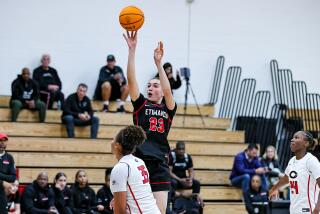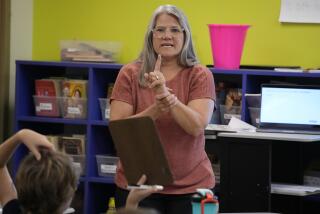Bee Reduces Math’s Sting : Fountain Valley Competition Builds Confidence, Skills
- Share via
FOUNTAIN VALLEY — When 10-year-old Jana Smith stood up on stage, she says she was so nervous her knees were wobbling. But once the show began, Jana performed like a trouper. In the end, the audience gave her a big round of applause, not because she can sing or dance, but because Jana can add, subtract, multiply and divide.
She was one of 42 mathematical performers who took part in an unusual show staged before 300 pupils and a handful of parents at Urbain H. Plavan Elementary School in Fountain Valley.
Math as entertainment?
Not exactly.
It was more like an old-fashioned spelling bee, but instead of spelling words, these contestants worked math problems. Using pencil and paper, top pupils from each grade competed against each other in a raucous event called the Math Bowl.
Now in its 10th year, the event began as a way to recognize youngsters who excel in mathematics, according to Julie Boyd, the third-grade teacher who coordinates the program.
“A group of parents and a group of teachers got together to come up with positive ways to recognize different people with different abilities,” she says. “So we came up with a variety of programs and the Math Bowl has become a tradition.”
In addition to the Math Bowl, the school also holds spelling bees and stages drama programs that recognize writing accomplishments.
Contestants in the Math Bowl are selected by individual teachers, says Boyd, and the emphasis is on fun, not competition. “It’s not a highly competitive event,” she says. “It’s mainly a way to give us an opportunity to recognize different areas of strengths among our students.”
Participants range from kindergartners to fifth-graders, and include children from Plavan’s special day classes for physically and communicatively disabled children. Math problems, submitted by teachers from each grade level, range from a simple two plus two equals four to a four-digit multiplication problem.
“All the problems were calculations,” Boyd explains. “And everyone was able to use pencil and paper.”
Problems were flashed on an overhead projector so that the entire audience could see them, and kids in the audience were encouraged to play along and try to come up with the answers on their own.
“The toughest problem we had was 287 milliliters equals how many liters?” Boyd says. “The answer is .287, but nobody got it.”
Another tough one required third-graders to add 3,942 and 2,301 and round off their answer.
Children competed by grade level, a grade at a time, writing their answers down on a piece of white paper on stage. “If they made a mistake, they were given a different color of paper and they continued writing,” Boyd says.
The idea was that, in the end, when only one piece of white paper was left on stage, that person was declared the winner. But it didn’t quite work that way--not in the first-, second- and third-grade competitions, all of which ended in ties. Dane Holmes and Connie Lin tied as first-grade champs, while Julieann Chang and Aaron Ackerson held on to win the second-grade title. Tying for the top spot in third grade were Bo Hamilton and Bryan Caforio.
Bryan, who admits to being a tad nervous, had a little trouble with multiplying 64 by 4, but still managed to come up with 256 and hung on until the finish. The 9-year-old, who hopes to grow up and become a baseball player, says that being in the Math Bowl taught him to slow down and take his time. “If you go really fast, then you get them wrong,” says Bryan.
Other Math Bowl champs include Roya Kamdare, 9, and Janey Woo, 10, both winners from the special day classes. Kim Nguyen, 11, won the fifth-grade title and Jana Smith took the top spot in fourth grade.
“The problems got harder as they went along,” says Jana, who aspires to be a pediatrician. She was nervous, she says, because she had never before competed in anything.
Now that she has, would she do it again, wobbly knees and all?
“Oh, yeah,” she says. “I really love math and I’m good at it.”
Jana’s teacher, Carole Flynn, is good at math too. She even does private math tutoring in grades up to the junior college level. Flynn is one of the Math Bowl’s biggest supporters, and she thinks that Plavan pupils benefit greatly from the annual competition.
“It’s good for the skills, of course, but it’s also the experience of the competition and it’s the feeling of confidence from being able to demonstrate that they have the knowledge and skills to compete at that level,” she says. “It’s also gives them an opportunity to be a leader and model appropriate behavior.”
Flynn, who has been teaching for 25 years, believes that American schools--and American students--often get a bum rap when it comes to subjects such as math. “Our students are very, very capable,” she says. “Students who have experienced some disappointment in school, once they can master math, they experience confidence and can then go on to try some of the other subjects in school that are not as precise.”
Principal Diane O’Donnell believes that events such as the Math Bowl get pupils excited about learning. “It definitely helps,” she says. “They can see that they have some recognition for things like this.”
And by presenting the competition on stage before pupils and parents, Math Bowl coordinator Boyd says the event accomplishes something else that is also important. “We had everything from kindergarten problems of 6 plus 1, all the way up to sophisticated calculations. So, it was real obvious what kids learn in six years of public school.”






